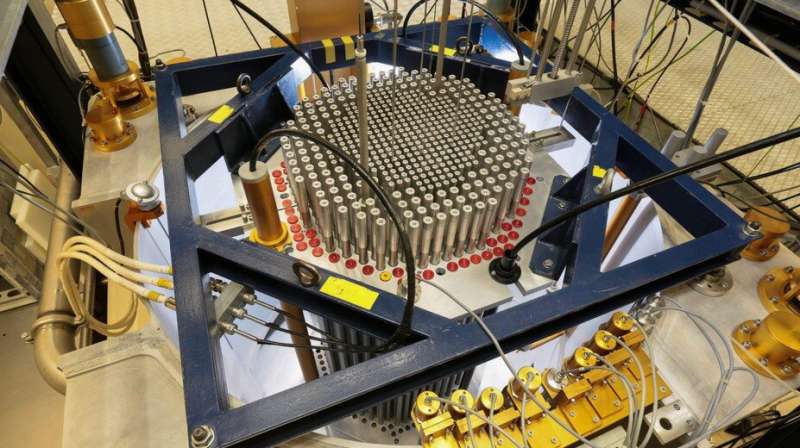This article has been reviewed according to Science X's editorial process and policies. Editors have highlighted the following attributes while ensuring the content's credibility:
fact-checked
peer-reviewed publication
trusted source
proofread
Gamma-ray method monitors nuclear reactors safely and quickly

Scientists at EPFL have devised and tested out a new, gamma-noise method for monitoring nuclear reactors non-invasively and from a distance. The new method, tested out on EPFL's CROCUS nuclear reactor, can improve nuclear safety and treaty compliance.
Monitoring nuclear reactors around the world to ensure that they comply with international treaties is essential for safety. But while current monitoring methods are effective, they often involve invasive procedures that can disrupt reactor operations or pose security risks.
In addition, nuclear technology is constantly evolving, creating new challenges for nuclear monitoring. For example, small modular reactors (SMRs) are compact and often installed in remote locations, while conventional monitoring methods are primarily designed for larger facilities, and may not be sufficiently adaptable or sensitive to the workings of SMRs.
Now, a team of researchers at EPFL and the Paul Scherrer Institut (PSI) have pioneered a non-invasive and more efficient technique using gamma noise to monitor reactors.
In a paper published in Scientific Reports, they show that gamma radiation—as opposed to the neutron signals used by traditional monitoring methods—can provide accurate and timely data on reactor criticality and composition without actual, physical intrusion into the reactor vessel.
The study was led by Oskari Pakari, a scientist with EPFL's Laboratory for Reactor Physics and Systems Behavior and the PSI's Nuclear Energy and Safety Research Division, led by Professor Andreas Pautz).
In their new monitoring method, the researchers used two bismuth germanate scintillators, which they strategically positioned outside EPFL's CROCUS research nuclear reactor, allowing them to non-invasively monitor gamma radiation emitted from its operation.
Gamma radiation is one of the types of electromagnetic radiation produced during nuclear fission—the process that happens inside a nuclear reactor—and gamma rays carry information about the reactor's state, such as changes in criticality and composition of its fuel (e.g., uranium) without directly interfering with the reactor's operations.
The new method also uses statistical analysis of the variability of gamma ray detection over time. Unlike conventional methods, which rely heavily on neutrons, gamma noise analysis focuses on the fluctuations in gamma ray counts, which correlate to the fission chain reactions occurring inside the reactor. It is the degree of correlation that provides insights into the reactor's operational state.
Finally, the method can provide essential data within minutes, a significant improvement over traditional methods, which typically require longer measurement times and closer proximity to the reactor core. Instead, the gamma-radiation method uses computational tools to analyze the temporal and spatial variance of detected gamma rays, which allows for rapid and accurate assessments of the reactor's condition.
The team tested out their method by extended experiments, successfully demonstrating its efficacy at distances up to several meters from the reactor core. The gamma-radiation monitoring detected prompt decay constants with minimal error, reducing the need for direct contact with the reactor core but also enhancing the speed and accuracy of data acquisition.
The new method provides reliable, non-invasive monitoring of various types of nuclear reactors, including SMRs. It could transform nuclear safety protocols, facilitate easier compliance with international treaties, and potentially be applied to other fields requiring radiation monitoring without direct sensor contact.
More information: Oskari Pakari et al, Gamma noise to non-invasively monitor nuclear research reactors, Scientific Reports (2024). DOI: 10.1038/s41598-024-59127-y

















